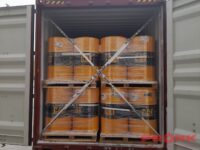5 Essential Points for Ensuring Effective Lashing Inside Containers
Properly securing cargo inside containers is crucial for maintaining safety and preventing damage during sea transportation. Lashing plays a vital role in securing cargo, preventing it from shifting or toppling during transit.
In this article, we will explore five essential points to ensure effective lashing inside containers, ensuring safe and secure transportation of goods in sea cargo.
 Understand the Cargo and Container Specifications: Before initiating the lashing process, it is crucial to understand the characteristics of the cargo and specifications of the container. Different cargo types require different lashing techniques and equipment. So you should consider containers’ size, weight limits, and available securing points while selecting the appropriate lashing method and lashing equipment for optimal security.
Understand the Cargo and Container Specifications: Before initiating the lashing process, it is crucial to understand the characteristics of the cargo and specifications of the container. Different cargo types require different lashing techniques and equipment. So you should consider containers’ size, weight limits, and available securing points while selecting the appropriate lashing method and lashing equipment for optimal security.
Use High-Quality Lashing Equipment: Investing in high-quality lashing equipment is vital to ensure effective cargo securement. The equipment should be strong, durable, and capable of withstanding the forces generated during sea transportation. Commonly used lashing equipment includes tensioners, lashing straps, chains, wire clips, twist locks, etc. You should also regularly inspect and maintain the equipment to ensure its reliability.
Proper Distribution and Weight Balance: Maintaining proper weight distribution and balance within the container is crucial for safe transportation. Uneven weight distribution can cause containers to tilt, leading to stability and loosening issues. Ensure that the cargo is evenly distributed from side to side and front to back. Avoid overloading one side or stacking cargo disproportionately, as this can jeopardize the container’s stability during transit.
Adequate Lashing Points and Techniques: Containers are usually designed with specific securing points to facilitate proper cargo lashing. You should Identify and utilize these securing points effectively. Consider the cargo’s shape, size, and weight to determine the suitable lashing technique. Common lashing methods include direct lashing, diagonal lashing, and transverse lashing. Distribute the lashing points evenly to provide comprehensive coverage and prevent cargo shifting or tipping.
Regular Inspection: To ensure the ongoing effectiveness of lashing material, regular inspections are essential. Conduct routine inspections to check the integrity of the lashing equipment, cargo securement, and overall container condition. Look for signs of wear and tear, loose lashings, and damaged securing points. Document the inspection results, including any corrective actions taken, to maintain a record of cargo safety compliance.
Proper lashing inside containers is crucial for safe and secure cargo transportation. By following these five essential points, you can enhance the effectiveness of lashing, minimize cargo movement, and mitigate the risk of damage or accidents. Understanding cargo and container specifications, using high-quality equipment, maintaining weight balance, employing suitable lashing techniques, and conducting regular inspections will contribute to a successful lashing process, ensuring the safe arrival of goods at their destination.
We use a wide variety of heavy duty lashing materials for lashing of cargo. Our materials include steel wire, lashing extension handle, ratchet tie down, tension lever, lashing chain, turnbuckle, steel wire rope, wire clip for wire ropes, car lashing, D ring, lashing shackle, load binder, load binder chain, and wheel choking.
Get in touch with us today to discuss your lashing requirements and see how we can help you – https://pronkmultiservice.com/contact/

